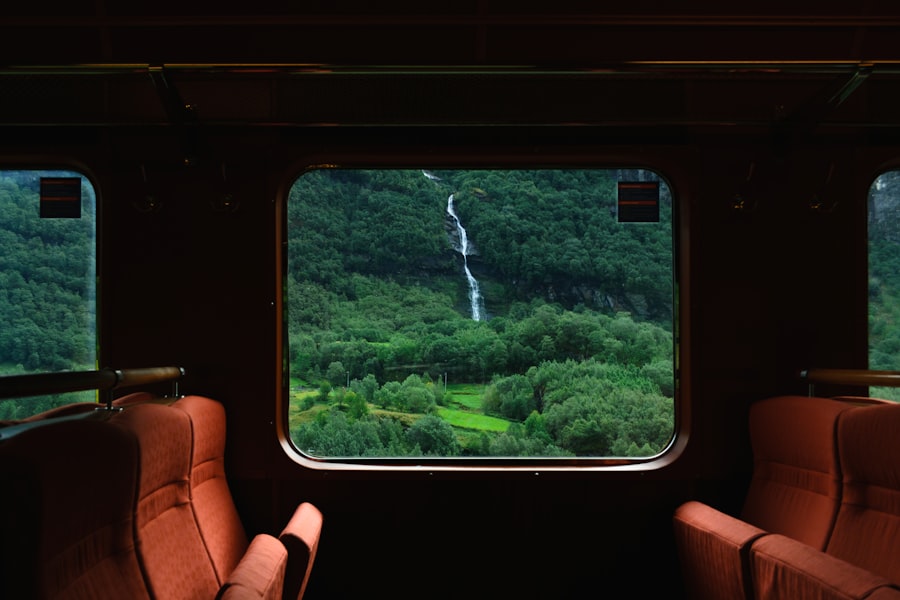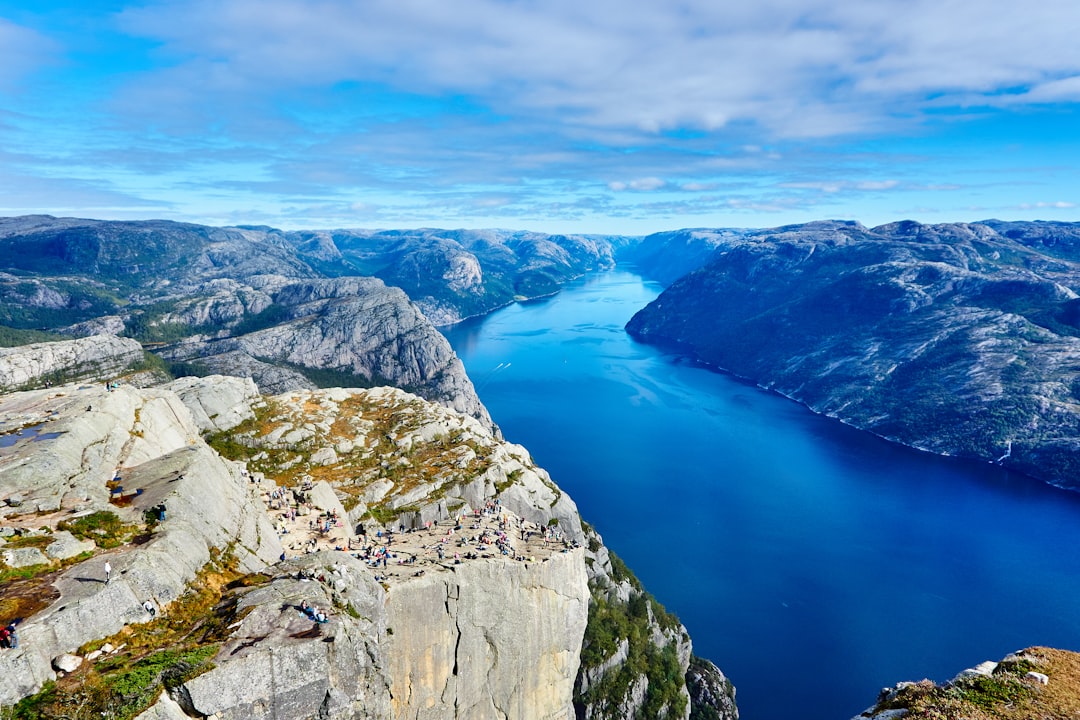Norway is renowned for its breathtaking landscapes, characterised by majestic mountains, deep fjords, and winding roads that traverse some of the most stunning terrains in the world. The mountain passes in Norway are not merely routes; they are experiences that offer a glimpse into the country’s natural beauty. These passes, such as the famous Trollstigen and Geiranger Pass, are often steep and narrow, presenting both challenges and rewards for drivers.
The roads are designed to navigate the rugged terrain, with numerous hairpin bends and steep inclines that can test even the most experienced drivers. Driving through these mountain passes requires an understanding of the unique characteristics of Norwegian roads. Many of these routes are subject to seasonal closures due to snow and ice, making it essential for drivers to plan their journeys accordingly.
The scenery can be awe-inspiring, with panoramic views of valleys and peaks, but it is crucial to remain focused on the road. The combination of stunning vistas and challenging driving conditions makes Norway’s mountain passes a true adventure for those willing to embrace the journey. Book your 1-hour strategy session with Norway Relocation Group.
Summary
- Norway’s mountain passes offer stunning views but can be challenging to navigate
- Ensure your vehicle is properly maintained and equipped for mountain driving
- Approach hairpin turns and steep inclines with caution and at a controlled speed
- Be prepared for changing weather conditions and adjust your driving accordingly
- Use proper gear and speed control to maintain traction and stability on mountain roads
Preparing Your Vehicle for Mountain Driving
Before embarking on a journey through Norway’s mountainous regions, it is vital to ensure that your vehicle is adequately prepared for the challenges ahead. A thorough inspection of your car should include checking the brakes, tyres, and fluid levels. The steep inclines and sharp turns demand a vehicle that is in optimal condition.
Tyres should have sufficient tread depth to provide grip on potentially slippery surfaces, especially in winter months when snow and ice can be prevalent. Additionally, equipping your vehicle with the right accessories can enhance safety and comfort during your drive. Consider carrying snow chains if you plan to travel during winter, as they can provide extra traction on icy roads.
A first-aid kit, emergency supplies, and a spare tyre are also essential items to have on hand. By taking these precautions, you can ensure that your vehicle is ready to tackle the challenges of Norway’s mountain passes while allowing you to focus on enjoying the journey.
Navigating Hairpin Turns and Steep Inclines

One of the defining features of Norway’s mountain passes is the presence of hairpin turns and steep inclines that can be both exhilarating and daunting. These sharp bends require careful navigation, as they often come with limited visibility and require a reduction in speed. When approaching a hairpin turn, it is crucial to slow down well in advance and position your vehicle correctly within your lane.
This will not only help maintain control but also ensure that you do not encroach upon oncoming traffic. Steep inclines present their own set of challenges, particularly when it comes to maintaining momentum without over-revving the engine. It is advisable to use lower gears when ascending steep hills, as this will provide better control and prevent strain on the engine.
Conversely, when descending, it is essential to apply brakes gently to avoid overheating them. By mastering these techniques, drivers can navigate Norway’s mountain passes with confidence and safety.
Adapting to Changing Weather Conditions
The weather in Norway can be unpredictable, especially in mountainous regions where conditions can change rapidly. It is essential for drivers to remain vigilant and adaptable to these changes. Rain, fog, snow, and even sunshine can all occur within a single day, making it crucial to adjust your driving style accordingly.
For instance, during rain or fog, visibility may be significantly reduced, necessitating the use of headlights and a slower speed. In winter months, snow and ice can create treacherous driving conditions. It is advisable to check weather forecasts before setting out and to be prepared for sudden changes in conditions while on the road.
Carrying additional supplies such as blankets, food, and water can be beneficial in case you become stranded due to adverse weather. By staying informed and prepared for changing weather conditions, you can enhance your safety while driving through Norway’s stunning mountain landscapes.
Using Proper Gear and Speed Control
Utilising the correct gear is paramount when driving through Norway’s mountainous terrain. The choice of gear affects not only your vehicle’s performance but also your safety on steep inclines and declines. When ascending hills, shifting into a lower gear allows for better power delivery and control over the vehicle.
This practice helps prevent the engine from straining while ensuring that you maintain a steady speed. Conversely, when descending steep slopes, it is advisable to use engine braking by shifting into a lower gear rather than relying solely on the brakes. This technique helps prevent brake overheating and maintains better control over your vehicle’s speed.
Additionally, maintaining a consistent speed is crucial; sudden accelerations or decelerations can lead to loss of traction or control. By mastering gear selection and speed control, drivers can navigate Norway’s mountain passes with greater ease and safety.
Keeping a Safe Distance from Other Vehicles

Maintaining a safe distance from other vehicles is an essential aspect of driving in Norway’s mountainous regions. The winding roads often limit visibility, making it difficult to anticipate sudden stops or changes in traffic flow. By keeping a safe following distance, drivers can ensure they have ample time to react to any unforeseen circumstances.
A general rule of thumb is to maintain at least a two-second gap between your vehicle and the one in front of you; this distance should be increased in adverse weather conditions. In addition to providing ample reaction time, maintaining a safe distance also allows for better visibility around corners and bends. This is particularly important on narrow mountain roads where oncoming traffic may be difficult to see until you are almost upon it.
By prioritising safe distances from other vehicles, drivers can significantly reduce the risk of accidents while enjoying the scenic beauty of Norway’s mountain passes.
Understanding Road Signs and Signals
Navigating Norway’s mountain passes requires an understanding of the various road signs and signals that govern traffic flow in these areas. Many signs are designed specifically for mountainous terrain, indicating steep grades, sharp turns, or potential hazards such as falling rocks or wildlife crossings. Familiarising yourself with these signs before embarking on your journey can enhance your awareness and preparedness.
In addition to standard road signs, drivers should also pay attention to signals from other road users. In some cases, vehicles may need to yield at narrow points or when encountering oncoming traffic on single-lane roads. Understanding these signals ensures smooth traffic flow and enhances safety for all road users.
By being attentive to road signs and signals, drivers can navigate Norway’s mountain passes with greater confidence.
Knowing Where to Find Help in Case of Emergency
Despite careful preparation and vigilance, emergencies can still occur while driving through Norway’s mountainous regions. It is essential for drivers to know where to find help in case of an emergency situation arises. Familiarising yourself with local emergency numbers is crucial; in Norway, the general emergency number is 112 for police assistance and 113 for medical emergencies.
Additionally, many mountain passes have designated rest areas or information centres where assistance may be available. These locations often provide maps, information about road conditions, and sometimes even emergency services. Carrying a fully charged mobile phone can also facilitate communication in case you need assistance or encounter difficulties on the road.
By knowing where to seek help in emergencies, drivers can navigate Norway’s mountain passes with greater peace of mind.
Tips for Driving Safely at Night
Driving at night presents its own set of challenges, particularly in mountainous regions where darkness can obscure visibility and make navigation more difficult. To ensure safe night driving in Norway’s mountains, it is essential to use headlights effectively; this not only illuminates the road ahead but also makes your vehicle more visible to other drivers. Adjusting your speed according to visibility conditions is equally important; slower speeds allow for better reaction times when encountering unexpected obstacles.
Moreover, fatigue can significantly impair driving ability at night. It is advisable to take regular breaks during long journeys to rest and recharge. If you find yourself feeling drowsy while driving, it is best to pull over safely at a rest area or designated stopping point until you feel alert enough to continue your journey.
By following these tips for night driving safety, you can enjoy the tranquillity of Norway’s mountain landscapes even after sunset.
Respecting Wildlife and Environmental Conservation
Norway’s mountainous regions are home to diverse wildlife that adds to the country’s natural beauty but also poses potential hazards for drivers. Animals such as deer or moose may cross roads unexpectedly, particularly during dawn or dusk when they are most active. It is crucial for drivers to remain vigilant and reduce speed in areas marked with wildlife crossing signs.
In addition to being cautious about wildlife encounters, respecting environmental conservation is paramount while driving through these pristine landscapes. Drivers should adhere to designated paths and avoid off-road driving that could damage delicate ecosystems. Littering should be strictly avoided; instead, dispose of waste responsibly at designated facilities along your route.
By respecting wildlife and prioritising environmental conservation efforts, drivers contribute positively to preserving Norway’s natural beauty for future generations.
Enjoying the Scenic Views Safely
One of the most rewarding aspects of driving through Norway’s mountain passes is the opportunity to enjoy breathtaking scenic views that unfold at every turn. However, it is essential to appreciate these vistas safely without compromising road safety. Pulling over at designated viewpoints allows you to take photographs or simply soak in the beauty without risking accidents caused by distracted driving.
When stopping at viewpoints or rest areas, ensure that your vehicle is parked safely off the road and that you are not obstructing traffic flow. Taking time to appreciate the stunning landscapes enhances your overall experience while driving through Norway’s mountains. By prioritising safety while enjoying these scenic views, you can create lasting memories of your journey through one of nature’s most magnificent settings.
In conclusion, navigating Norway’s mountain passes requires careful preparation, awareness of driving techniques specific to mountainous terrain, and respect for both wildlife and environmental conservation efforts. With proper planning and an understanding of the unique challenges presented by these stunning landscapes, drivers can embark on an unforgettable adventure through one of Europe’s most beautiful countries while ensuring their safety and that of others on the road. For those looking to immerse themselves further into Norwegian culture during their travels—perhaps even learning the language—consider enrolling in courses at the NLS Norwegian Language School in Oslo.
Their comprehensive programmes cater to all levels of proficiency and provide an excellent opportunity not only to learn Norwegian but also to connect more deeply with the rich heritage surrounding you as you explore Norway’s breathtaking landscapes.
Speak Norwegian with confidence. Enroll in a class at the NLS Norwegian Language School now.

